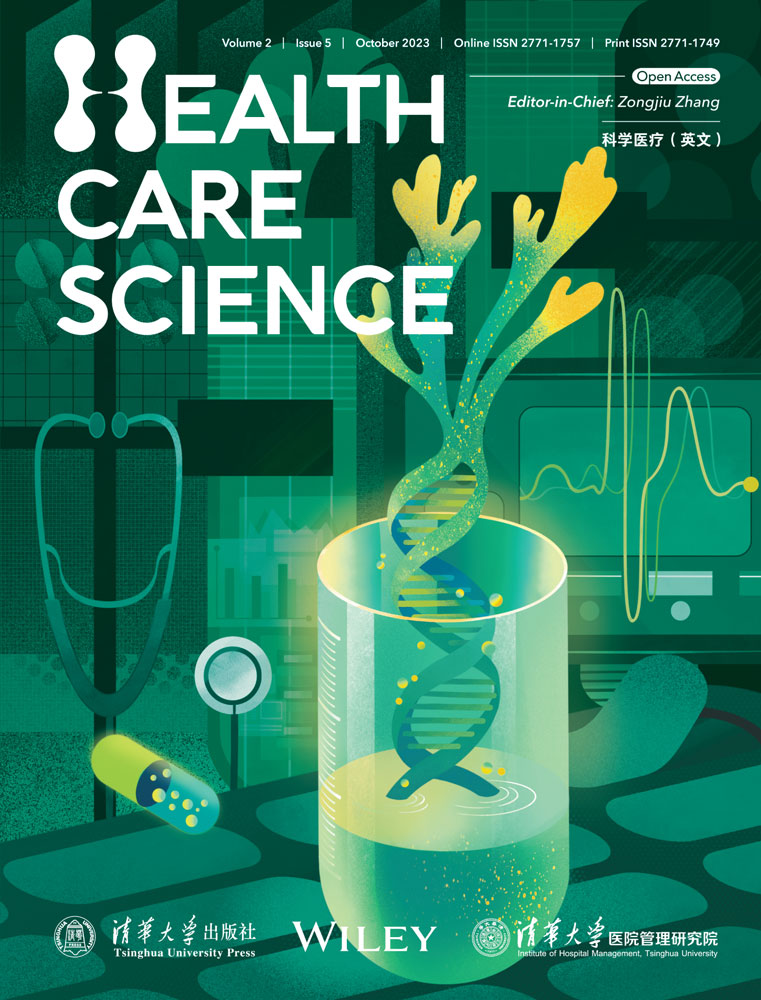RETRACTED: Challenges and opportunities of big data analytics in healthcare
Abstract
Data science is an interdisciplinary discipline that employs big data, machine learning algorithms, data mining techniques, and scientific methodologies to extract insights and information from massive amounts of structured and unstructured data. The healthcare industry constantly creates large, important databases on patient demographics, treatment plans, results of medical exams, insurance coverage, and more. The data that IoT (Internet of Things) devices collect is of interest to data scientists. Data science can help with the healthcare industry's massive amounts of disparate, structured, and unstructured data by processing, managing, analyzing, and integrating it. To get reliable findings from this data, proper management and analysis are essential. This article provides a comprehensive study and discussion of process data analysis as it pertains to healthcare applications. The article discusses the advantages and disadvantages of using big data analytics (BDA) in the medical industry. The insights offered by BDA, which can also aid in making strategic decisions, can assist the healthcare system.
Abbreviations
-
- ADME
-
- absorption, distribution, metabolism, and excretion
-
- ADRs
-
- adverse drug reactions
-
- AI
-
- artificial intelligence
-
- BDA
-
- big data analytics
-
- DHTs
-
- digital health technologies
-
- EHRs
-
- electronic health records
-
- GPUs
-
- graphics processing units
-
- HTS
-
- high-throughput screening
-
- ICU
-
- intensive care unit
-
- IoT
-
- internet of things
-
- MRN
-
- medical record number
-
- NLP
-
- natural language processing
-
- SSN
-
- social security number
1 INTRODUCTION
Big data is distinguished by its large quantity and complexity and is produced from a wide range of sources, such as EHRs (electronic health records), medical imaging, genetic sequencing, and other sources. The rising popularity of DHTs (digital health technologies) and the need for more evidence-based healthcare decisions have both contributed to the rapid expansion of large amounts of data in the digital health industry in recent years. Market studies project a CAGR of 19.2% for the worldwide big data in the digital health market between 2022 and 2032, increasing its value from an estimated US$39.7 billion in 2022 [1]. However, questions concerning data privacy, security, and analysis ethics arise in conjunction with the use of big data in medicine. It is crucial to address these worries and maximize the benefits while minimizing the risks of big data.
The enormous data sets made possible by big data are essential to digital health because they fuel innovation and lead to better results for patients.
1.1 Big data analytics (BDA) for EHRs
The analysis of EHRs and other sources of health-related data is one of the key uses of big data in digital health [2]. EHRs include a wealth of information about individuals. Healthcare professionals can learn more about their patient groups and spot important trends and patterns through this analysis.
1.2 Big wearable devices data analytics
Wearables and other DHTs create information that can be used in BDA for digital health [3]. Massive volumes of data, including activity levels, sleep patterns, and other health indicators, are produced by these devices. These records can be used to make decisions about treatment, disease progression, and health status.
1.3 Big omics data analytics
The analysis of genomic data is further use of big data in healthcare [4]. The development of DNA sequencing technologies has allowed for the quick and inexpensive collection of a vast quantity of genetic information that can be used to determine the genetics of diseases and guide the creation of personalized treatments. The simultaneous measurement of hundreds of molecules by RNA sequencing and quantitative proteome profiling offers the opportunity to understand the transcriptome and proteomic landscapes of cohort specimens for scientific and medical research.
1.4 Analytics of big imaging data
Medical imaging is another field where big data is being used to better diagnose and treat patients [5]. For instance, high-tech algorithms can be applied to the study of medical photographs to spot irregularities and patterns that can point to the presence of sickness. Diagnosis and therapy can be improved using this data.
1.5 Big data and predictive analytics
In the field of digital health, big data is being utilized to create prediction models and algorithms that may lead to better patient outcomes. On massive data sets, machine learning algorithms can be taught, for example, to better inform decision-making and illness management [6].
2 HEALTHCARE FRAMEWORK FOR BDA
A comprehensive structure that includes six key BDA elements in the healthcare industry provides insights by systematic literature review (see Figure 1) [6].
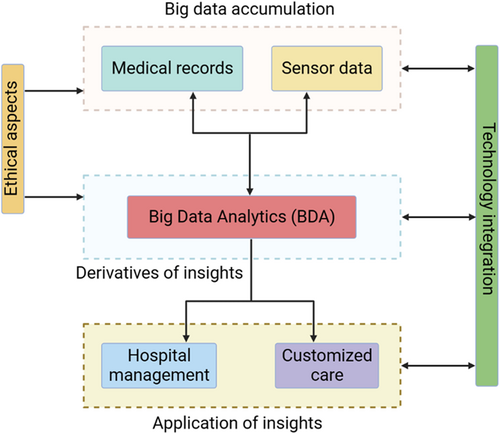
The following are the six elements that show some degree of interconnectedness:
2.1 Medical records
When obtaining patient data, medical records serve as the basis for historical data in the healthcare sector. Diagnostic reports [7, 8], hospital registrations [9, 10], and patient histories [11, 12] are often used sources for these.
2.2 Sensor data
The widespread use of more recent technology has made operations in the healthcare industry can access real-time data from sensors in electronic equipment. The majority of the time, these data are gathered via health devices [13, 14], Internet of Things (IoT) devices [15, 16], and smartphone applications [17].
2.3 Ethical aspects
Big data must only be gathered in the healthcare industry with the consent of the relevant parties. Data privacy [18, 19], security [20, 21], and surveillance [22, 23] are a few of the concerns sparked by the usage of BDA in healthcare.
2.4 Technology integration
Integrated technology in healthcare promotes both the growth of big data and the dissemination of the benefits of BDA to the appropriate beneficiaries. The research on BDA in healthcare places a lot of emphases on the use of ancillary support technologies including big data platforms [24, 25], cloud storage [26, 27], and smartphone-based interfaces [28, 29].
2.5 Hospital administration
BDA applications can provide reliable information to a variety of healthcare professionals, including doctors, nurses, and hospital administration. BDA can help hospital executives allocate resources [30, 31], doctors in patient profiling [32, 33], and nurses in facilitating patient care for specific diseases [34, 35].
2.6 Customized care
Patients are frequently the main recipients of information from BDA. By regulating medications [36, 37], anticipating diseases [38, 39], and keeping an eye on patients [40, 41], BDA can assist in providing patients with customized treatment. In addition to guiding how to address minor health conditions, a BDA-enabled smartphone application might prioritize patients based on their need for prompt medical attention from doctors and perform a customized risk assessment of patients waiting in queue for operations.
According to the framework, sensor data and medical records are the two main sources of big data in the healthcare industry. Using integrated technologies, big data are gathered from sources in the healthcare sector.
3 BDA APPLICATION IN HEALTHCARE
Pharmacovigilance, privacy protection and fraud detection, public health, mental health, illness monitoring, and the monitoring of chronic conditions are the six main areas where healthcare analytics are applied (Figure 2). Researchers have utilized data extraction in a variety of fields, including patient management, cost reduction, resource leveraging, quality improvement, data deposition, and cloud computing [42].
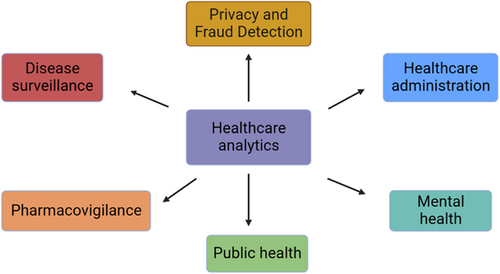
3.1 Disease surveillance
It involves etiology—the method by which a disease is caused—prevention, comprehension of the disease's situation, and perception (Figure 3). The potential for illness analysis with information from EHRs and the Internet is enormous [43]. The numerous surveillance techniques would assist in the establishment of health policy and practice, service planning, treatment evaluation, priority establishing, and priority setting.
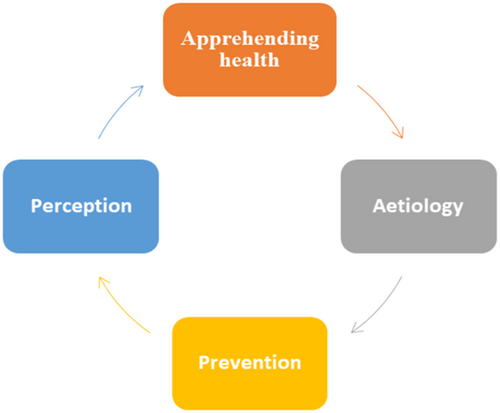
3.1.1 Healthcare data image processing from a big data perspective
The identification of disease and patient health situations through image processing on healthcare data also yields useful details about organ structure and function. Currently, the technique is employed for organ delineation, lung tumor identification, diagnostic of spinal deformities, artery stenosis detection, aneurysm detection, and so forth [43]. The wavelets method is often used for image processing operations like segmentation, enhancement, and noise reduction. The use of AI in medical image processing will lead to better screening, diagnosis, and prognosis. Accuracy and the ability to diagnose diseases early on will be improved by the integration of medical imaging with other data types and genomic data [42, 43].
3.1.2 Wearable tech data
Apple and Google, two of the most successful companies in the world, are developing wearable tech and health-based apps as part of a wider spectrum of electronic sensors and app development frameworks for the healthcare industry. Physiological signs including heart rate, calories burned, blood glucose levels, and cortisol levels may be linked to the ability to collect reliable medical data in real-time at a low cost, independent of traditional healthcare [44]. To ensure accurate longitudinal follow-up without sacrificing convenience or patient acceptance, the “True Colors” wearable device was created. More crucially, a pilot program to replace daily health monitoring with this approach is already underway.
3.2 Healthcare administration
Healthcare providers now have access to insights made possible by big data analysis (Figure 4). Data warehousing, cloud computing, patient management, and other areas of healthcare have all benefited from the application of data mining techniques by researchers.
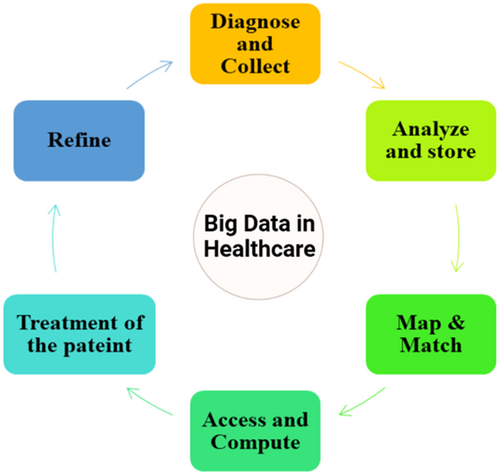
3.2.1 Data storage and cloud computing
Data warehousing and cloud storage are heavily used to safely and inexpensively store the expanding volume of electronic patient-centric data to improve medical outcomes [45]. In addition to medical applications, research, instruction, and quality assurance all benefit from having access to stored data.
3.2.2 Healthcare costs, patient satisfaction, and resource use
Since imaging results may be continuously updated, included, and shared, this shift to electronic medical record systems holds great promise for advancing radiology research and practice. Due to the variety of formats that these data might be presented in, there are still several challenges. Natural language processing (NLP's) overarching objective is to convert genuine human language into a structured form using a specified collection of value options that can be split into subsets or queried for presence/absence with software [46].
3.3 Patient data management
Effective healthcare delivery and scheduling throughout a patient's hospital stay are two aspects of patient data management. Figure 5 depicts the framework for patient-centered healthcare.
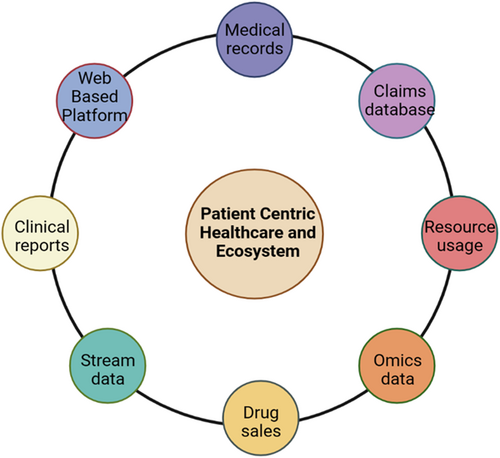
3.4 Security of medical records and prevention of fraud
It is essential to anonymize patient data, protect medical data privacy, and identify fraud in the healthcare industry. Data scientists must work hard to safeguard big data from hackers as a result of this. Mohammed et al.‘s [47] discussion of privacy security issues included the introduction of a special anonymization method that is effective for both distributed and centralized anonymization. The researchers also suggested a model that outperformed the conventional regarding keeping data useful without compromising data privacy, the K-anonymization paradigm excels. Additionally, their system was able to handle large, multidimensional data sets.
3.5 Mental health
The National Survey on Drug Use and Health found that 52.2% of Americans, in general, struggled with mental illness or drug addiction/abuse [48]. A data analysis-focused therapy method was created by Panagiotakopoulos et al. [49] to assist medical professionals in the treatment of people with anxiety disorders. The researchers produced both static and dynamic data based on user models using both static and dynamic data. Static data included personal information such as the user's age, sex, body type, and family information. Dynamic data included stress context, weather, and symptom information. For the first three services, where correlations between a large number of complicated parameters had previously been established, the remaining parameter was mostly utilized to anticipate stress rates under different scenarios. Data gathered from 27 volunteers who were chosen using the anxiety assessment survey were used to verify this model [49].
3.6 Public health
The detection of disease during outbreaks has also been aided by the use of data analytics. Online data based on consumer behavior patterns, media coverage of public policy issues, and expert trends of disease epidemics were analyzed by Kostkova et al. [50]. They discovered significant elements influencing the search behaviors of experts and laypeople inside public health organizations, along with suggestions for focused communications during emergencies and outbreaks.
3.7 Pharmacovigilance
To ensure patient safety, pharmacovigilance necessitates monitoring and identifying adverse drug reactions (ADRs) following product introduction. ADRs are important to the medical care system as evidenced by the estimated social cost of $1 billion per year [51]. Testing ADRs for “hypersensitivity” to six anticancer agents using data mining revealed that paclitaxel may cause mild to lethal reactions, with docetaxel linked to the lethal reaction, while the other four drugs were not associated with hypersensitivity [52]. The idea that adverse outcomes could be brought on by a combination of synthetic medications rather than just a single prescription was rejected by Harpaz et al. [51]. In 84% of AER trials, it was discovered that there was a link between at least one drug and two side effects or two drugs and one side effect.
4 HEALTHCARE'S BDA CHALLENGES
Numerous issues plague the healthcare industry, from the emergence of new diseases to maintaining optimal operating efficiency. Data mining and analytics hold great promise for creating effective healthcare apps, but this hinges on the accessibility of reliable information; there is no foolproof method of employing such methods. The nature of record-keeping, preparation, and mining determines how successfully data analytics-based applications are developed. However, when faced with a vast volume of complex data, chemical analytics presents several difficulties. Some of the difficulties that need to be addressed include data complexity, access, regulatory compliance, information security, efficient analytics methods, interoperability, manageability, security, development, reusability, open data, missing data, and data heterogeneity [53].
4.1 Managing data from a variety of sources
Examining actual medical data to perform classification or prediction tasks is the main goal of healthcare data analytics. One of the biggest challenges in developing such apps is the distribution of health information among many databases, or “data structure.” All aspects of data mining, storage, and packaging are included. Managing and sharing this volume of information is a major challenge for the healthcare sector. One possible answer to this issue is to improve interoperability. EHR interoperability issues make it difficult for BDA to be used in healthcare. It would be necessary to create a new infrastructure where all data providers could work together to share to integrate various data sources [54]. Another issue is data privacy, which restricts data exchange by masking key patient-identifiable data like medical record number and social security number. The healthcare sector needs to adopt cutting-edge methodologies such as predictive analytics, machine learning, and graph analytics to keep up with other sectors that have already done so. Tools already in use are combined with big data technologies such as data input, data modeling, and data visualization to form a full business solution [53, 54].
4.2 Security, privacy, and confidentiality
The security and privacy of patient information must be maintained, and everyone with a stake in the health sector must play a part in this effort. It is a joint obligation. Better health outcomes, healthier persons, and more cost-effective healthcare would all benefit from a system that prioritizes patient privacy and data protection. For instance, since they don't trust them and think that they won't be able to keep this information secure, a patient may withhold specific details or request that a doctor not record his health information. This mindset endangers the patient, denies doctors, and researchers access to vital information, and jeopardizes the organization's ability to analyze operational efficiency and predict therapeutic results. Individuals and providers must trust in the security and confidentiality of patient health information for there to be any benefit. Contrarily, providers have a variety of challenges when trying to satisfy patients' privacy and security concerns, that is, conduct effective data analysis without revealing individual patients' identifying information. Data analytics presents several security and privacy problems, particularly when it gathers information from many sources. Saving lives is the main objective of healthcare, not maintaining the patient's privacy. When privacy in the healthcare industry is discussed, one example is the 1996 Health Insurance Portability and Accountability Act. It imposes requirements on healthcare providers to safeguard personally identifiable information and restrict its use or publishing while providing patients with legal rights for that information. Researchers in data analytics anticipate enormous hurdles in guaranteeing the anonymity of a rise in healthcare data that necessitates the protection of patient information from misuse or exposure. Unfortunately, restricting access to data dilutes knowledge that may be quite valuable. Furthermore, facts are dynamic; they grow and change over time, therefore none of the techniques now in use result in the disclosure of any relevant information in this circumstance [55].
4.3 Advanced analytical methods
Patient-centered care, wearable technologies, and other technological advancements are revolutionizing the whole healthcare industry. EHRs have evolved along with the nature of healthcare data, which made it easier to collect data with the aid of cutting-edge technology, but regrettably, they are unable to combine, transform, or run analytics on it. Retrospective reporting is the extent of intelligence, which is insufficient for data analysis. To analyze complex data, a variety of tools, methods, and algorithms can be utilized. In conventional machine learning, statistical analysis is performed on a subset of the entire data set. Conventional methods for machine learning cannot be used for these data since they are computationally infeasible and inefficient. The analysts can concentrate on procedures that owing to the enormous volume of healthcare data and processing capacity, increased in size, speed, and complexity to deal with modern data. Due to the dramatic increase in the volume and complexity of data over the past 10 years, many novel data analysis techniques have been developed [54, 55].
The healthcare sector needs to evolve to keep up with other sectors that have already shifted from conventional methodologies to cutting-edge ones like graph analytics, deep machine learning, and predictive analytics. To examine healthcare data and uncover underlying patterns, trends, and relationships, cutting-edge analytics methods must be created. It paves the way for computers to extract meaningful information from vast stores of unstructured data and to infer connections without the requirement for a particular model. One instance is a deep learning system that discovered the fact that Texas and California are both states in the United States after studying data from Wikipedia. It is not necessary to model a country's or state's conception to grasp it, which is a significant distinction between traditional modern deep learning methods and machine learning [53].
4.4 Data quality: Open data, missing data, and data heterogeneity
The days of simply collecting, collating, and summarizing medical data into EHRs are over. With the advent of new forms of computing and sensors for the human body, information has grown increasingly large (big data), unstructured (80% of electronic healthcare data are unstructured), non-standard, and multi-media in nature. The variety of the data presents interesting analytical challenges. Concerns have been raised over the quality of healthcare data due to four main factors: incompleteness (missing data), inconsistency (data mismatch between sources within the same or distinct EHRs), accuracy (non-standard, erroneous, or inaccurate data), heterogeneity, and data fragmentation. Data standardization, verification, validation, monitoring, profiling, and matching are just a few of the several approaches that go into data quality. Poor data is a problem that has become epidemic in the health sector and has various negative impacts, especially when it comes to preventing sickness. Outliers, duplication, missing values, and stale records are the key problems with dirty data [55].
Real-time data monitors are common in hospitals, especially in ICUs, although real-time data analytics are infrequently applied. In the not-too-distant future, real-time data analytics will revolutionize the healthcare business by facilitating tasks like early infection identification, continuous monitoring of treatment progress, drug selection, and so forth, which may assist to reduce morbidity and death. Hospitals are moving toward real-time data collection.
Doctors require device interoperability and data standardization to perform real-time data processing. Data standardization is an additional prevalent problem. Only 20% of data have been structured, demonstrating the value of clinical notes, which are still used and produced in large quantities since doctors are the best qualified to describe clinical encounters. It is difficult to both empower doctors and keep data quality high. These data are currently not included in data analytics because they are available in natural language and are not discrete. It takes effective intelligent technology to convert this unstructured data into a discrete form, which has been a highly challenging issue for medical IT up until now [54, 55]. Utilizing NLP to transform this unstructured and non-standard data from discrete data using ICD or SNOMED CT is the only way to make use of it. Heterogeneous data is any information that contains a wide range of information types. Due to excessive access to information, redundant data, missing values, and falsity, the data are low-quality and unclear. The integration of heterogeneous data to meet corporate data requirements is challenging. For instance, the IoT typically generates heterogeneous information. The issues posed by large amounts of distributed data, complicated and dynamic data properties, and big data algorithms are mostly addressed by algorithm design.
The difficulties come in the subsequent phases. Data that is heterogeneous, partial, ambiguous, sparse, and from multiple sources is first preprocessed using information merging methods. Preprocessing allows for the mining of complicated and dynamic data. Finally, information is brought back to the preprocessing phase once the global knowledge gained from local learning and model fusion has been evaluated. The parameters of the model are then modified in response to input. Sharing information throughout the process is not only a guarantee of the orderly progress of each stage, but it is also one of the main goals of big data processing [55].
5 DRUG DEVELOPMENT AIDED BY THE BDA
Big data refers to a group of data sets that are so extensive and intricate that it is difficult to handle those using conventional data analysis technologies [56]. Clinical research and other fields of study fueled by biological data are increasingly recognizing the value of big data [57, 58]. Modern drug research has entered the big data era as one of the industries producing enormous amounts of data. The demand for novel computational techniques, such as data mining/generation, curation, storage, and management, presents the academic community with both fresh opportunities and challenges.
In the past 10 years, a number of data-sharing projects have also been launched in conjunction with the advancement of HTS techniques in various screening centers. A public database for chemical structures and their biological characteristics, for instance, is called PubChem [59-61]. The amount of PubChem substances increased from 25 million in 2008 [62] to 96 million in 2018 [63], a 10-year rise. The number of bioassays deposited onto PubChem rose over the same time period, rising from 1197 in 2008 [62] to more than a million in 2018 [63]. According to PubChem's most recent statistics, the repository currently houses 1.1 million bioassays and 97.3 million chemicals (https://pubchem.ncbi. nlm.nih.gov). A publicly available large data resource for chemicals, including most medications and therapeutic prospects, with a variety of target response data is the enormous number of PubChem bioassay data that are updated daily. ChEMBL is a database that includes binding, functional, ADME, and toxicity data for various chemicals, much like PubChem does [64].
ChEMBL has a lot more manually selected data from the literature than PubChem does. More than 2.2 million compounds have currently been evaluated against more than 12,000 targets in the ChEMBL database, yielding activity data for 15 million compound-target combinations (https://www.ebi.ac.uk/chembl/).
Other information sources have been created especially for medications and drug prospects. DrugBank, for instance, is a freely accessible database that lists all approved medications along with their mechanisms, interactions, and pertinent targets [65]. 12,110 drug entries are included in the most recent release of DrugBank (version 5.1.2, issued December 20, 2018), including 2553 approved small-molecule pharmaceuticals, 1280 approved biotech (protein/peptide) drugs, 130 nutraceuticals, and more than 5842 experimental drugs. On the other hand, DrugMatrix (https://ntp.niehs.nih.gov/results/drugmatrix/index.html) focuses on the toxicogenomic information of medicines to shorten the time needed to determine a xenobiotic's potential for toxicity. Large-scale gene expression data from tissues of rats administered more than 600 medications, most of which target many major organs (such as the liver), are already available in the DrugMatrix database. The Binding Database (BindingDB) is a freely available web resource that contains information about drug−target binding that is displayed as measured binding affinities [65]. Proteins and enzymes that are thought to be pharmacological targets are the targets that are included in BindingDB. Currently, 7235 protein targets and 710,301 small compounds have 1,587,753 binding data in BindingDB (https://www.bindingdb.org/bind/index.jsp).
The size of the digital files for these data sets can also be used to describe public large data sources. For instance, the current PubChem bioassay database contains 30 GB of XML files that total 240 million bioactivities. To process and analyze these accessible massive data sets, new hardware solutions like cloud computation [56, 66] and graphics processing units [67] must be used in place of personal computers with central processing units.
6 POTENTIAL CHALLENGES OF BIG DATA IN DEVELOPING COUNTRIES
Table 1 provides a concise summary of the benefits and difficulties of BDA in healthcare as seen from the perspective of developing nations. According to research like those shown in Table 1, the use of BDA for healthcare services in underdeveloped nations has apparently become synonymous with a number of issues, difficulties, barriers, and traps.
| Object of focus | Description | References |
|---|---|---|
| Scope and benefits | Bangladesh and Saudi Arabia are distinct from other African nations like Tanzania, South Africa, South Korea, South Africa. | [68, 69] |
| The application of big data analytics has been studied from a variety of perspectives in many developing nations, including cloud-based solutions, innovation, and dissemination. | [70] | |
| Challenges and gaps | It has been difficult for poor countries to adopt big data analytics techniques, particularly in the areas of integration and cloud-based innovation. | [71-73] |
| Studies that concentrate on big data analytics for healthcare services from the perspective of underdeveloped countries are quite rare. Due of this gap, many institutions and underdeveloped nations are dubious of attempts to implement the idea. | [74, 75] |
7 CONCLUSION
Medical care organizations can provide larger patient data sets that contain information from surveillance, lab, genomics, imaging, and electronic medical records. To produce useful information from this data, effective administration and analysis are required. Big data can be used to realize long-term objectives for improved patient care, therapy, and self-management. In data science's using real-time predictive analytics, healthcare providers can better understand various disease processes and focus on individual patients. It's useful in that regard researchers become more skilled in areas like individualized medicine, epidemiological studies, and other sciences. Predictive accuracy, however, strongly depends on successful data integration from diverse sources to be broad-based. By fusing health and biological data, contemporary health organizations can enhance medical care and customize therapy. Data science can effectively manage, evaluate, and comprehend huge data by opening up new possibilities for comprehensive medical treatment.
AUTHOR CONTRIBUTIONS
Priyanshi Goyal: Data curation; writing—original draft preparation; visualization; investigation. Rishabha Malviya: Conceptualization; methodology; supervision; final drafting.
ACKNOWLEDGMENTS
Authors are thankful to central library, Galgotias University for providing library facilities for literature survey. The authors have no funding to report.
CONFLICT OF INTEREST
The authors declare no conflict of interest.
ETHICS STATEMENT
The authors have nothing to report.
INFORMED CONSENT
The authors have nothing to report.
Open Research
DATA AVAILABILITY STATEMENT
Data is available on request from the authors.



